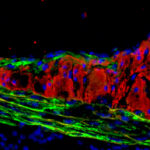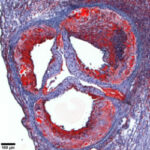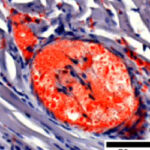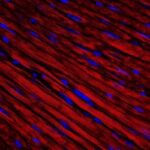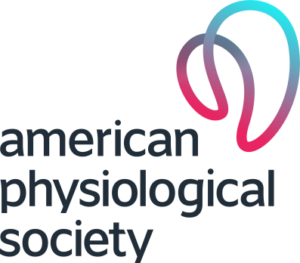What We Do
The Trigatti Lab is part of the Department of Biochemistry and Biomedical Sciences at McMaster University and the Thrombosis & Atherosclerosis Research Institute of McMaster University and Hamilton Health Sciences in Hamilton, Ontario, Canada.
Our research is focused on the molecular mechanisms involved in the development of atherosclerosis, a chronic inflammatory disease characterized by the development of cholesterol-rich plaques in the arteries. Atherosclerosis is one of the major causes of coronary heart disease and a leading cause of hospitalization and death worldwide. Using mouse molecular genetics, we aim to determine and characterize the contributions of a variety of physiological pathways involved in atherosclerotic development and resulting cardiovascular disease.
Who We Are
Principal Investigator
Bernardo Trigatti
BSc, PhD
Professor, Department of Biochemistry and Biomedical Sciences
Thrombosis and Atherosclerosis Research Institute
David Braley Cardiac, Vascular and Stroke Research Institute, RM C4-104
Hamilton General Hospital Campus
237 Barton Street East
Hamilton, Ontario, Canada
L8L 2X2

Bernardo Trigatti
BSc, PhD
Professor, Department of Biochemistry and Biomedical Sciences
Bernardo Trigatti
BSc, PhD
Professor, Department of Biochemistry and Biomedical Sciences
Thrombosis and Atherosclerosis Research Institute
David Braley Cardiac, Vascular and Stroke Research Institute, RM C4-104
Hamilton General Hospital Campus
237 Barton Street East
Hamilton, Ontario, Canada
L8L 2X2
Bernardo Trigatti
BSc, PhD
Professor, Department of Biochemistry and Biomedical Sciences
Thrombosis and Atherosclerosis Research Institute
David Braley Cardiac, Vascular and Stroke Research Institute, RM C4-104
Hamilton General Hospital Campus
237 Barton Street East
Hamilton, Ontario, Canada
L8L 2X2
Postdoctoral Fellows
George Kluck
BSc, MSc, PhD
Postdoctoral Fellow
George’s project focuses on understanding the molecular mechanisms that regulate atherosclerosis development. Specifically, his research focuses on the role of the adapter protein PDZK1, which binds to the C-terminal of the scavenger receptor class B type 1 (SR-B1), the main receptor for high-density lipoproteins (HDL).
Wei Wang
BSc, MSc, PhD
Postdoctoral Fellow
Wei’s research focuses on exploring the effects of sphingosine 1-phosphate receptor 1 and 2 signalling on proliferation and phenotypic switching of vascular smooth muscle cells during atherosclerosis development.
George Kluck
BSc, MSc, PhD
Postdoctoral Fellow
George’s project focuses on understanding the molecular mechanisms that regulate atherosclerosis development. Specifically, his research focuses on the role of the adapter protein PDZK1, which binds to the C-terminal of the scavenger receptor class B type 1 (SR-B1), the main receptor for high-density lipoproteins (HDL).
George Kluck
BSc, MSc, PhD
Postdoctoral Fellow
George’s project focuses on understanding the molecular mechanisms that regulate atherosclerosis development. Specifically, his research focuses on the role of the adapter protein PDZK1, which binds to the C-terminal of the scavenger receptor class B type 1 (SR-B1), the main receptor for high-density lipoproteins (HDL).
Wei Wang
BSc, MSc, PhD
Postdoctoral Fellow
Wei’s research focuses on exploring the effects of sphingosine 1-phosphate receptor 1 and 2 signalling on proliferation and phenotypic switching of vascular smooth muscle cells during atherosclerosis development.
Wei Wang
BSc, MSc, PhD
Postdoctoral Fellow
Wei’s research focuses on exploring the effects of sphingosine 1-phosphate receptor 1 and 2 signalling on proliferation and phenotypic switching of vascular smooth muscle cells during atherosclerosis development.
Graduate Students
Ting Xiong
BSc
PhD Candidate
Ting is researching the effects of PCSK9 inhibition on coronary artery disease and myocardial infarction in mouse models and the potential mechanisms involved.
Alexander Qian
BSc
PhD Candidate
Alex’s research project studies the intricacies of macrophage cell death, specifically, proteins in the Bcl-2 family that initiate programmed cell death on the progression and development of atherosclerosis. One aspect of his project seeks to determine how high-density lipoprotein protects macrophages against programmed cell death and the effects on Bcl-2 family proteins.
Narmadaa Thyagarajan
BTech, MSc
PhD Candidate
Narmadaa is investigating the role of the G-protein coupled receptor sphingosine-1-phosphate receptor type 1 in experimental atherosclerosis.
Sumayyah Sokeechand
BSc
PhD Candidate
Sumayyah’s project focuses on the inflammatory aspects of atherosclerosis, specifically pertaining to the role of interleukin receptor alpha (IL-15Ra) in atherosclerotic development.
Jeong-Ah Yoo
BSc, MSc
PhD Candidate
Jeong-Ah is investigating the mechanism behind high-density lipoprotein (HDL) protection against chemotherapy-induced heart damage.
Ting Xiong
BSc
PhD Candidate
Ting is researching the effects of PCSK9 inhibition on coronary artery disease and myocardial infarction in mouse models and the potential mechanisms involved.
Ting Xiong
BSc
PhD Candidate
Ting is researching the effects of PCSK9 inhibition on coronary artery disease and myocardial infarction in mouse models and the potential mechanisms involved.
Alexander Qian
BSc
PhD Candidate
Alex’s research project studies the intricacies of macrophage cell death, specifically, proteins in the Bcl-2 family that initiate programmed cell death on the progression and development of atherosclerosis. One aspect of his project seeks to determine how high-density lipoprotein protects macrophages against programmed cell death and the effects on Bcl-2 family proteins.
Alexander Qian
BSc
PhD Candidate
Alex’s research project studies the intricacies of macrophage cell death, specifically, proteins in the Bcl-2 family that initiate programmed cell death on the progression and development of atherosclerosis. One aspect of his project seeks to determine how high-density lipoprotein protects macrophages against programmed cell death and the effects on Bcl-2 family proteins.
Narmadaa Thyagarajan
BTech, MSc
PhD Candidate
Narmadaa is investigating the role of the G-protein coupled receptor sphingosine-1-phosphate receptor type 1 in experimental atherosclerosis.
Narmadaa Thyagarajan
BTech, MSc
PhD Candidate
Narmadaa is investigating the role of the G-protein coupled receptor sphingosine-1-phosphate receptor type 1 in experimental atherosclerosis.
Sumayyah Sokeechand
BSc
PhD Candidate
Sumayyah’s project focuses on the inflammatory aspects of atherosclerosis, specifically pertaining to the role of interleukin receptor alpha (IL-15Ra) in atherosclerotic development.
Sumayyah Sokeechand
BSc
PhD Candidate
Sumayyah’s project focuses on the inflammatory aspects of atherosclerosis, specifically pertaining to the role of interleukin receptor alpha (IL-15Ra) in atherosclerotic development.
Jeong-Ah Yoo
BSc, MSc
PhD Candidate
Jeong-Ah is investigating the mechanism behind high-density lipoprotein (HDL) protection against chemotherapy-induced heart damage.
Jeong-Ah Yoo
BSc, MSc
PhD Candidate
Jeong-Ah is investigating the mechanism behind high-density lipoprotein (HDL) protection against chemotherapy-induced heart damage.
Undergraduate Students
Lauren Wong
Undergraduate Student
Lauren is currently investigating the molecular mechanisms of coronary artery atherosclerosis and myocardial infarction development in the SR-B1/apoE double knockout mouse model of coronary heart disease.
Lauren Wong
Undergraduate Student
Lauren is currently investigating the molecular mechanisms of coronary artery atherosclerosis and myocardial infarction development in the SR-B1/apoE double knockout mouse model of coronary heart disease.
Lauren Wong
Undergraduate Student
Lauren is currently investigating the molecular mechanisms of coronary artery atherosclerosis and myocardial infarction development in the SR-B1/apoE double knockout mouse model of coronary heart disease.
Former Lab Members
Yak Deng
BSc
Research Technician

Yak Deng
BSc
Research Technician
Christine Bassila
BSc, MSc, PhD
Postdoctoral Fellow
Christine’s research focuses on investigating the protein-protein interactions implicated in scavenger receptor class B type 1 (SR-B1) mediated high density lipoprotein (HDL) signaling in macrophages.
Samuel Lee
BMSc (Hons), MSc, PhD
PhD Graduate
Sam is examining the effects of older age on the development of coronary artery atherosclerosis and myocardial infarction in atherogenic mice. He is also investigating the effects of platelet knockout and inhibition on coronary artery atherothrombosis and myocardial infarction in atherogenic mice.
Louise Lee
BSc, MSc
MSc Graduate
Louise’s project focuses on using novel inhibitors to understand the role of hemostatic pathways in the development of coronary atherothrombosis and myocardial infarction.
Emmanuel Sakarya
BSc, MSc
MSc Graduate
Emmanuel’s research focuses on the athero-protective, multi-domain protein PDZK1 in macrophages. Specifically, he seeks to determine which PDZK1 isoform is expressed in macrophages, and he will conduct a structure and function analysis to determine which domains and features of PDZK1 are involved in athero-protection.
Jennifer Nouanesengsy
Undergraduate Student
Jennifer is interested in investigating the role of G-protein coupled receptor, sphingosine-1-phosphate receptor type 1, in vascular smooth muscle cells.
Yak Deng
BSc
Research Technician
Yak Deng
BSc
Research Technician
Christine Bassila
BSc, MSc, PhD
Postdoctoral Fellow
Christine’s research focuses on investigating the protein-protein interactions implicated in scavenger receptor class B type 1 (SR-B1) mediated high density lipoprotein (HDL) signaling in macrophages.
Christine Bassila
BSc, MSc, PhD
Postdoctoral Fellow
Christine’s research focuses on investigating the protein-protein interactions implicated in scavenger receptor class B type 1 (SR-B1) mediated high density lipoprotein (HDL) signaling in macrophages.
Samuel Lee
BMSc (Hons), MSc, PhD
PhD Graduate
Sam is examining the effects of older age on the development of coronary artery atherosclerosis and myocardial infarction in atherogenic mice. He is also investigating the effects of platelet knockout and inhibition on coronary artery atherothrombosis and myocardial infarction in atherogenic mice.
Samuel Lee
BMSc (Hons), MSc, PhD
PhD Graduate
Sam is examining the effects of older age on the development of coronary artery atherosclerosis and myocardial infarction in atherogenic mice. He is also investigating the effects of platelet knockout and inhibition on coronary artery atherothrombosis and myocardial infarction in atherogenic mice.
Louise Lee
BSc, MSc
MSc Graduate
Louise’s project focuses on using novel inhibitors to understand the role of hemostatic pathways in the development of coronary atherothrombosis and myocardial infarction.
Louise Lee
BSc, MSc
MSc Graduate
Louise’s project focuses on using novel inhibitors to understand the role of hemostatic pathways in the development of coronary atherothrombosis and myocardial infarction.
Emmanuel Sakarya
BSc, MSc
MSc Graduate
Emmanuel’s research focuses on the athero-protective, multi-domain protein PDZK1 in macrophages. Specifically, he seeks to determine which PDZK1 isoform is expressed in macrophages, and he will conduct a structure and function analysis to determine which domains and features of PDZK1 are involved in athero-protection.
Emmanuel Sakarya
BSc, MSc
MSc Graduate
Emmanuel’s research focuses on the athero-protective, multi-domain protein PDZK1 in macrophages. Specifically, he seeks to determine which PDZK1 isoform is expressed in macrophages, and he will conduct a structure and function analysis to determine which domains and features of PDZK1 are involved in athero-protection.
Jennifer Nouanesengsy
Undergraduate Student
Jennifer is interested in investigating the role of G-protein coupled receptor, sphingosine-1-phosphate receptor type 1, in vascular smooth muscle cells.
Jennifer Nouanesengsy
Undergraduate Student
Jennifer is interested in investigating the role of G-protein coupled receptor, sphingosine-1-phosphate receptor type 1, in vascular smooth muscle cells.
Research
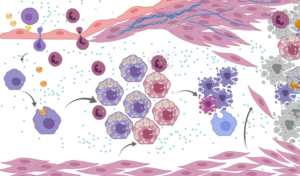
Atherosclerosis is a multifactorial disease driven by interactions between circulating lipoproteins, inflammatory cells and cells of the arterial wall. The disease results from dysregulated lipid metabolism and inflammation. Circulating low density lipoproteins (LDL) may be retained in the artery wall and chemically modified, triggering an inflammatory response resulting in the recruitment of monocytes. The monocytes are subsequently differentiated into macrophage foam cells, characterized by a buildup of cholesterol in the cytoplasm from the uptake of modified lipoproteins. The foam cells comprise fatty streaks in the arterial intima and develop into atherosclerotic plaque as the disease progresses. In late stages of atherosclerosis, a necrotic core forms in the plaque as a result of high rates of macrophage cell death and the defective clearance of dead cells. A large, lipid-rich necrotic core destabilizes the atherosclerotic plaque leading to plaque rupture, causing the formation of a thrombus and potentially leading to ischemia.
High density lipoproteins (HDL) counter the development of atherosclerosis through mediating reverse cholesterol transport, a process through which cholesterol is removed from the foam cells of the atherosclerotic plaque. HDL transports the cholesterol to the liver where hepatocytes secrete the cholesterol into the bile for reuptake or disposal. Reverse cholesterol transport is driven by ATP binding cassette transporters (ABCA1 and ABCG1) in macrophages and by the HDL receptor, scavenger receptor class B type 1 (SR-B1) in the liver. HDL also protects against atherosclerosis by activating signaling pathways in cells (like macrophages and endothelial cells) in the artery wall leading to atheroprotective responses.
In the Trigatti Lab, we are interested in investigating molecular pathways that drive the development of atherosclerosis. In particular, our ongoing projects focus on the role of the HDL receptor SR-B1 in protection against atherosclerosis in coronary arteries, the role of HDL signaling in modulating cell death within atherosclerotic plaques, other molecular pathways that modulate atherosclerosis development and the role of signaling by HDL in cardiomyocytes in protecting against cardiotoxicity.
Current Research
Learn more about our research focuses.
Publications
Recent Publications
Fuller, M.T., Dadoo, O., Xiong, T., Chivukula, P., MacDonald, M.E., Lee, S.K., Austin, R.C., Igdoura, S.A., and Trigatti, B.L. (2022). Extensive diet-induced atherosclerosis in scavenger receptor class B type 1-deficient mice is associated with substantial leukocytosis and elevated vascular cell adhesion molecule-1 expression in coronary artery endothelium. Front Physiol 13, 1023397. 10.3389/fphys.2022.1023397.
Kluck, G.E.G., Qian, A.S., Sakarya, E.H., Quach, H., Deng, Y.D., and Trigatti, B.L. (2023). Apolipoprotein A1 Protects Against Necrotic Core Development in Atherosclerotic Plaques: PDZK1-Dependent High-Density Lipoprotein Suppression of Necroptosis in Macrophages. Arteriosclerosis, Thrombosis, and Vascular Biology, 43, 45–63. doi: 10.1161/ATVBAHA.122.318062
Kluck, G.E.G., Yoo, J. A., Sakarya, E.H., and Trigatti, B.L. (2021). Good Cholesterol Gone Bad? HDL and COVID-19. International Journal of Molecular Sciences, 22, 10182. doi:10.3390/ijms221910182
Xiong, T., Qian, A.S., and Trigatti, B.L. (2021). The local effects of proprotein convertase subtilisin/kexin type 9 (PCSK9) on the inflammatory atheroma: beyond LDL cholesterol lowering. Vessel Plus, 5(5). doi: 10.20517/2574-1209.2020.71
Kluck, G.E.G, Durham, K. K., Yoo, J. A., & Trigatti, B. L. (2020). High Density Lipoprotein and Its Precursor Protein Apolipoprotein A1 as Potential Therapeutics to Prevent Anthracycline Associated Cardiotoxicity. Frontiers in cardiovascular medicine, 7, 65. doi: 10.3389/fcvm.2020.00065
Rodriguez, A., Trigatti, B. L., Mineo, C., Knaack, D., Wilkins, J. T., Sahoo, D., Asztalos, B. F., Mora, S., Cuchel, M., Pownall, H. J., Rosales, C., Bernatchez, P., Ribeiro Martins da Silva, A., Getz, G. S., Barber, J. L., Shearer, G. C., Zivkovic, A. M., Tietge, U., Sacks, F. M., Connelly, M. A., … Martel, C. (2019). Proceedings of the Ninth HDL (High-Density Lipoprotein) Workshop: Focus on Cardiovascular Disease. Arteriosclerosis, thrombosis, and vascular biology, 39(12), 2457–2467. doi: 10.1161/ATVBAHA.119.313340
Sokeechand, B., & Trigatti, B. L. (2019). Un-JAMming atherosclerotic arteries: JAM-L as a target to attenuate plaque development. Clinical science (London, England : 1979), 133(14), 1581–1585. doi: 10.1042/CS20190541
Durham, K. K., Kluck, G.E.G, Mak, K. C., Deng, Y. D., & Trigatti, B. L. (2019). Treatment with apolipoprotein A1 protects mice against doxorubicin-induced cardiotoxicity in a scavenger receptor class B, type I-dependent manner. American journal of physiology. Heart and circulatory physiology, 316(6), H1447–H1457. doi: 10.1152/ajpheart.00432.2018
Gonzalez, L., MacDonald, M. E., Deng, Y. D., & Trigatti, B. L. (2018). Hyperglycemia Aggravates Diet-Induced Coronary Artery Disease and Myocardial Infarction in SR-B1-Knockout/ApoE-Hypomorphic Mice. Frontiers in physiology, 9, 1398. doi: 10.3389/fphys.2018.01398
Yu, P., Qian, A. S., Chathely, K. M., & Trigatti, B. L. (2018). Data on leukocyte PDZK1 deficiency affecting macrophage apoptosis but not monocyte recruitment, cell proliferation, macrophage abundance or ER stress in atherosclerotic plaques of LDLR deficient mice. Data in brief, 19, 1148–1161. doi: 10.1016/j.dib.2018.05.128
Yu, P., Qian, A. S., Chathely, K. M., & Trigatti, B. L. (2018). PDZK1 in leukocytes protects against cellular apoptosis and necrotic core development in atherosclerotic plaques in high fat diet fed ldl receptor deficient mice. Atherosclerosis, 276, 171–181. doi: 10.1016/j.atherosclerosis.2018.05.009
Durham, K. K., Chathely, K. M., & Trigatti, B. L. (2018). High-density lipoprotein protects cardiomyocytes against necrosis induced by oxygen and glucose deprivation through SR-B1, PI3K, and AKT1 and 2. The Biochemical journal, 475(7), 1253–1265. doi: 10.1042/BCJ20170703
Yu, P., Xiong, T., Tenedero, C. B., Lebeau, P., Ni, R., MacDonald, M. E., Gross, P. L., Austin, R. C., & Trigatti, B. L. (2018). Rosuvastatin Reduces Aortic Sinus and Coronary Artery Atherosclerosis in SR-B1 (Scavenger Receptor Class B Type 1)/ApoE (Apolipoprotein E) Double Knockout Mice Independently of Plasma Cholesterol Lowering. Arteriosclerosis, thrombosis, and vascular biology, 38(1), 26–39. doi: 10.1161/ATVBAHA.117.305140
Durham, K. K., Chathely, K. M., Mak, K. C., Momen, A., Thomas, C. T., Zhao, Y. Y., MacDonald, M. E., Curtis, J. M., Husain, M., & Trigatti, B. L. (2018). HDL protects against doxorubicin-induced cardiotoxicity in a scavenger receptor class B type 1-, PI3K-, and Akt-dependent manner. American journal of physiology. Heart and circulatory physiology, 314(1), H31–H44. doi: 10.1152/ajpheart.00521.2016
For a complete list of publications, please visit PubMed.
Other Links
Information Box Group
Contact
Information Box Group
Bernardo Trigatti
BSc, PhD
Professor, Department of Biochemistry and Biomedical Sciences
Thrombosis and Atherosclerosis Research Institute
David Braley Cardiac, Vascular and Stroke Research Institute, RM C4-104
Hamilton General Hospital Campus
237 Barton Street East
Hamilton, Ontario, Canada
L8L 2X2

Bernardo Trigatti
BSc, PhD
Professor, Department of Biochemistry and Biomedical Sciences
Bernardo Trigatti
BSc, PhD
Professor, Department of Biochemistry and Biomedical Sciences
Thrombosis and Atherosclerosis Research Institute
David Braley Cardiac, Vascular and Stroke Research Institute, RM C4-104
Hamilton General Hospital Campus
237 Barton Street East
Hamilton, Ontario, Canada
L8L 2X2
Bernardo Trigatti
BSc, PhD
Professor, Department of Biochemistry and Biomedical Sciences
Thrombosis and Atherosclerosis Research Institute
David Braley Cardiac, Vascular and Stroke Research Institute, RM C4-104
Hamilton General Hospital Campus
237 Barton Street East
Hamilton, Ontario, Canada
L8L 2X2
Interested graduate students and postdoctoral fellows are encouraged to send Dr. Trigatti a cover letter with a statement of interest, a curriculum vitae (CV), a transcript/grade report and two recommendation letters from faculty members familiar with the research background of the student.
Further McMaster information and resources
Prospective graduate students may consult the following websites for entrance requirements and admissions information:
- School of Graduate Studies
- Faculty of Health Sciences Graduate Studies
- Biochemistry Graduate Program
- Medical Sciences Graduate Program
















